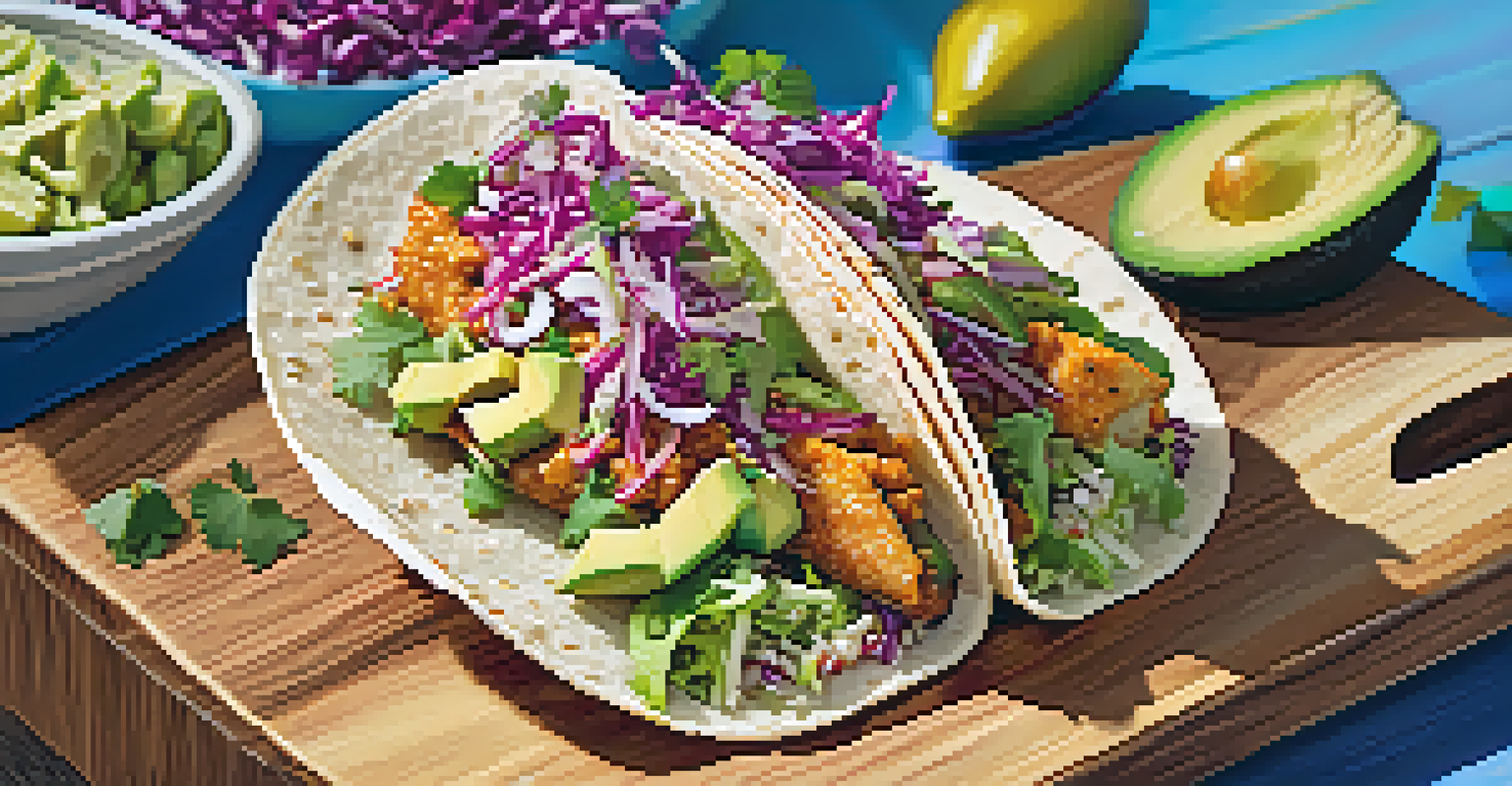Discovering Plant-Based Seafood Alternatives from Different Cultures

The Rise of Plant-Based Seafood Alternatives
As more people seek sustainable diets, plant-based seafood alternatives are gaining popularity. These innovative options are not just for vegans; they appeal to anyone looking to reduce their environmental footprint. With seafood being a staple in many cultures, the challenge is to recreate those beloved flavors and textures using plant ingredients.
The future of food is the future of the planet.
Countries around the world are embracing this trend, leading to an exciting fusion of traditional recipes with new ingredients. From algae-based fish fillets to jackfruit crab cakes, the creativity is endless. This movement is not just about substitution; it's about celebrating the ocean's flavors while preserving marine life.
As we explore different cultures, we’ll uncover how they’re reinventing seafood dishes, making them accessible to everyone. This journey promises to be a delicious one, with plant-based options that are not only healthy but also full of taste.
Asian Influences: Seaweed and Beyond
In many Asian cuisines, seaweed has long been a staple, often serving as a base for various seafood dishes. From sushi to miso soup, seaweed is not just nutritious; it’s also packed with umami flavor. Recent innovations have taken this ancient ingredient and transformed it into fish-like textures, making it a popular choice for plant-based seafood.

For example, in Japan, you can find plant-based sushi rolls filled with a mixture of seaweed and tofu, mimicking the taste and texture of fish. Similarly, in Korea, dishes like 'miyeok-guk' (seaweed soup) are being adapted with plant-based ingredients that capture the essence of seafood without harming marine life. These adaptations not only respect tradition but also enhance the culinary experience.
Plant-Based Seafood is Rising
The popularity of plant-based seafood alternatives is growing as more people seek sustainable dietary options.
This blend of tradition and innovation illustrates how cultures are evolving to meet modern dietary needs while honoring their culinary heritage. As we dig deeper into Asian cuisine, we find an array of delicious options that are sure to please both seafood lovers and plant-based eaters alike.
Mediterranean Delights: From Fennel to Fakes
Mediterranean cuisine is renowned for its rich flavors and fresh ingredients, making it an ideal ground for plant-based seafood alternatives. Take, for instance, dishes like 'fakes' (lentil soup) that can be enhanced with seaweed or other plant-based ingredients to evoke a seafood essence. The use of herbs and spices adds depth to these dishes, making them satisfying and flavorful.
You don’t have to be a vegetarian to enjoy plant-based meals.
Additionally, Mediterranean countries are experimenting with ingredients like chickpeas and artichokes to create crab cakes and fish-like patties. These dishes not only provide an alternative but also promote the use of local ingredients, reducing the carbon footprint associated with seafood transportation. The emphasis on fresh, wholesome foods aligns perfectly with the plant-based movement.
As we explore these culinary innovations, it's evident that the Mediterranean region is embracing plant-based seafood with open arms. The fusion of flavors and textures creates a vibrant dining experience that celebrates both tradition and sustainability.
Latin American Flavors: Jackfruit and More
Latin American cuisine offers a treasure trove of plant-based seafood alternatives, particularly with the versatile jackfruit. This tropical fruit has a texture similar to pulled pork, making it an excellent base for plant-based fish tacos or ceviche. With the right seasonings, jackfruit can easily absorb the flavors of traditional seafood dishes, making it a favorite among plant-based cooks.
In countries like Mexico and Brazil, chefs are creatively reinterpreting classic seafood recipes using jackfruit, tofu, and even hearts of palm. These ingredients bring a unique twist to dishes such as 'tacos de pescado' (fish tacos) and 'moqueca' (a seafood stew). The explosion of flavors and textures makes these alternatives not just a substitute, but an exciting experience.
Cultural Innovations in Cuisine
Various cultures are creatively adapting traditional seafood dishes using plant-based ingredients while honoring their culinary heritage.
This culinary creativity reflects a broader shift in Latin American cuisine, where sustainability meets tradition. By incorporating local ingredients into beloved recipes, these dishes celebrate the rich heritage of the region while offering a compassionate choice for seafood lovers.
North American Innovations: From Cauliflower to Crab
In North America, the plant-based seafood movement is making waves with inventive alternatives that appeal to a broad audience. Cauliflower, for instance, is being used to create crab cakes that are both satisfying and delicious. With the right blend of spices and sauces, these dishes can rival their seafood counterparts in both taste and texture.
Beyond crab cakes, companies are developing fish fillets made from sustainable ingredients, including pea protein and algae. These products are designed to mimic the taste and feel of traditional fish, catering to those who miss the flavors of the sea. It's a win-win situation: delicious food that also supports environmental sustainability.
As more people turn to plant-based diets, North American chefs and brands are rising to the occasion, continually innovating and expanding their menus. This vibrant culinary scene is encouraging diners to explore new flavors while being kind to the planet.
European Traditions: Reimagining Seafood Classics
Across Europe, chefs are reimagining traditional seafood classics with plant-based alternatives that delight the palate. For instance, in the UK, vegan fish and chips have become a popular dish, using battered banana blossoms or tofu to replicate the crispy texture of fish. This twist on a beloved classic showcases how innovation can breathe new life into traditional recipes.
In Scandinavian countries, dishes like 'klippfisk' (dried fish) are being transformed with ingredients such as tempeh and mushrooms, bringing a modern touch to age-old recipes. These alternatives maintain the essence of the original dishes while providing a plant-based option for those who prefer it. The focus on local and sustainable ingredients is a common theme throughout these adaptations.
Future Trends in Plant-Based Seafood
As demand increases, the plant-based seafood market is set to expand with innovations that enhance flavor and texture, catering to a broader audience.
As European chefs continue to experiment and innovate, the plant-based seafood landscape is expanding rapidly. The emphasis on creativity and sustainability makes these dishes not only appealing but also a celebration of culinary heritage.
The Future of Plant-Based Seafood: Trends and Predictions
Looking ahead, the future of plant-based seafood alternatives appears bright, with trends indicating a surge in innovation and accessibility. As consumer demand for sustainable and healthy options grows, manufacturers are investing in research and development to create even more convincing seafood substitutes. This could include advancements in flavor, texture, and nutritional profiles.
Moreover, as more people adopt plant-based diets, restaurants and grocery stores are expanding their offerings to include a diverse range of plant-based seafood products. This accessibility will not only cater to vegans and vegetarians but also appeal to flexitarians and seafood lovers looking to reduce their consumption of animal products.

Ultimately, the shift towards plant-based seafood is not just a trend but a necessary evolution in our food systems. By embracing these alternatives, we can contribute to a healthier planet while enjoying the rich flavors inspired by cultures around the world.